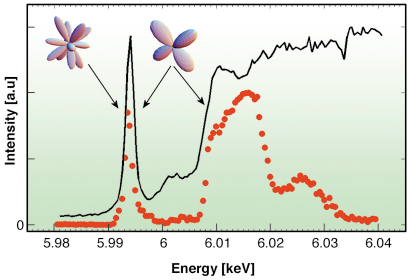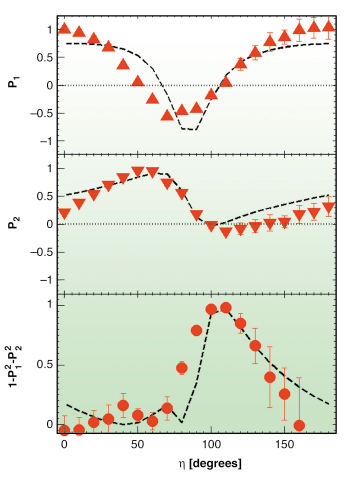- Home
- Users & Science
- Scientific Documentation
- ESRF Highlights
- ESRF Highlights 2006
- X-ray Absorption and Magnetic Scattering
- Disentangling multipole resonances through a full X-ray polarisation analysis
Disentangling multipole resonances through a full X-ray polarisation analysis
In the last 10 years resonant X-ray scattering (RXS) has developed into a powerful technique to obtain direct information about charge, magnetic, and orbital degrees of freedom. It combines the resolution in the determination of long-range ordered structures of X-ray diffraction with the sensitivity to local electronic configurations of X-ray absorption spectroscopy. The development of third generation synchrotron radiation sources has made possible the detection of small effects in electronic distribution: a new interpretation of RXS experiments in terms of electromagnetic multipoles has led to the detection of phase transitions characterised by order parameters of exotic symmetry. However, in several cases the assignment of the multipolar origin to an RXS signal was not clear. The characteristic variation of the intensity and polarisation as the sample is rotated about the scattering vector during an azimuthal scan may allow a clearer identification of the order of the multipole. However, an azimuthal scan cannot be realised in the case of restrictive sample environments such as a cryomagnet or a high pressure cell. Moreover, it is very difficult to identify and separate two resonances of different multipolar origin when they are separated by less than 1 eV. This situation frequently occurs in oxides at the pre-edge region of transition metal K-edges, or at L2,3 edges of rare-earth compounds, where E1 and E2 transitions can have similar magnitudes.
 |
|
Fig. 117: K2CrO4 absorption coefficient and (130) |
These problems can be addressed by the experimental technique developed at beamline ID20, based on the combination of a diamond phase plate to rotate the incident linear X-ray polarisation with respect to the plane of the synchrotron and a linear polarisation analysis of the diffracted beam (so called polarisation scans). The technique allows the determination of the Pointcarè-Stokes’ parameters P1 (degree of horizontal-vertical linearly polarised light) and P2 (degree of polarised light inclined at 45°-135°) as a function of the angle of rotation ![]() of the incoming linearly polarised beam. P3 (degree of right-left circularly polarised light) is not directly accessible in this setup. For fully polarised light P12+P22+P32 = 1, where -1 < Pi < 1, i = {1,2,3}. The polarisation analysis of the diffracted beam can resolve resonances determined by multipolar tensors of different order that are very close in energy, playing on their different relative phase shifts. Polarisation scans were performed at the pre-edge region of the Cr K-edge (E = 5994 eV) in K2CrO4. In this compound an electric quadrupole tensor (E1-E1 channel) and an electric hexadecapole tensor (E2-E2 channel) are responsible for the strong resonance in the (130) glide-plane forbidden reflection (Figure 117; cartoon pictures show the shape of the two tensors involved in the scattering while the black arrows indicate the energy ranges of the respective contributions). Figure 118 shows the measured results: we discovered a degree of linear polarisation very different from 1 in a wide angular range (bottom panel). Ab-initio calculation fit the data nicely (Figure 118, dashed lines), indicating that the missing linear polarisation is fully converted into a circular one. A “time reversed” experiment indeed confirmed that this was the case: by impinging on the sample with a circularly polarised beam we obtained a diffracted beam fully linearly polarised. Polarisation scans performed at the Cr K-edge energy (E = 6010 and 6018 eV), where only the E1-E1 channel is expected to contribute, detected a complete linearly polarised (P12+P22 = 1) scattered beam.
of the incoming linearly polarised beam. P3 (degree of right-left circularly polarised light) is not directly accessible in this setup. For fully polarised light P12+P22+P32 = 1, where -1 < Pi < 1, i = {1,2,3}. The polarisation analysis of the diffracted beam can resolve resonances determined by multipolar tensors of different order that are very close in energy, playing on their different relative phase shifts. Polarisation scans were performed at the pre-edge region of the Cr K-edge (E = 5994 eV) in K2CrO4. In this compound an electric quadrupole tensor (E1-E1 channel) and an electric hexadecapole tensor (E2-E2 channel) are responsible for the strong resonance in the (130) glide-plane forbidden reflection (Figure 117; cartoon pictures show the shape of the two tensors involved in the scattering while the black arrows indicate the energy ranges of the respective contributions). Figure 118 shows the measured results: we discovered a degree of linear polarisation very different from 1 in a wide angular range (bottom panel). Ab-initio calculation fit the data nicely (Figure 118, dashed lines), indicating that the missing linear polarisation is fully converted into a circular one. A “time reversed” experiment indeed confirmed that this was the case: by impinging on the sample with a circularly polarised beam we obtained a diffracted beam fully linearly polarised. Polarisation scans performed at the Cr K-edge energy (E = 6010 and 6018 eV), where only the E1-E1 channel is expected to contribute, detected a complete linearly polarised (P12+P22 = 1) scattered beam.
 |
|
Fig. 118: Polarisation scan on the (130) reflection at E = 5994 eV measured with linearly polarised incident beam. |
Polarisation analysis of RXS experiments has developed greatly in the last few years, helping our understanding of characteristic order parameters in transition metal oxides, rare-earth based compounds, and actinides. However, a full investigation of Pointcarè-Stokes’ parameters had never been carried out, most likely because linear polarisation analysis was considered sufficient. While linear polarisation analysis may be sufficient when just one excitation channel is involved, several dephasing phenomena may appear when two different excitations close in energy contribute to the transition. As described above, these phenomena may lead to a situation where a scattering process converts an incoming linear polarisation into a circular one due to an interference between two multipolar tensors. The use of phase plates and of a complete polarisation analysis is the key to disentangling multi-resonance structures in those situations where just an energy scan (see Figure 117) is not sufficient. This technique allows a sensitive determination of the relative strength of the multipoles involved and a deeper insight into complex phase transitions and ordering phenomena, being in turn a powerful tool to finely investigate electronic configurations of solid state materials.
Principal Publication and Authors
C. Mazzoli (a), S.B. Wilkins (a,b), S. Di Matteo (c), B. Detlefs (a,d), C. Detlefs (a), V. Scagnoli (a), L. Paolasini (a) and P. Ghigna (e), Phys. Rev. Lett., submitted.
(a) ESRF
(b) Brookhaven National Laboratory, Upton (USA)
(c) INFN, Lab. Naz. di Frascati (Italy)
(d) Institute for Transuranium Elements, Karlsruhe (Germany)
(e) Dip.to di Chimica Fisica, Univ. di Pavia, Pavia (Italy)



